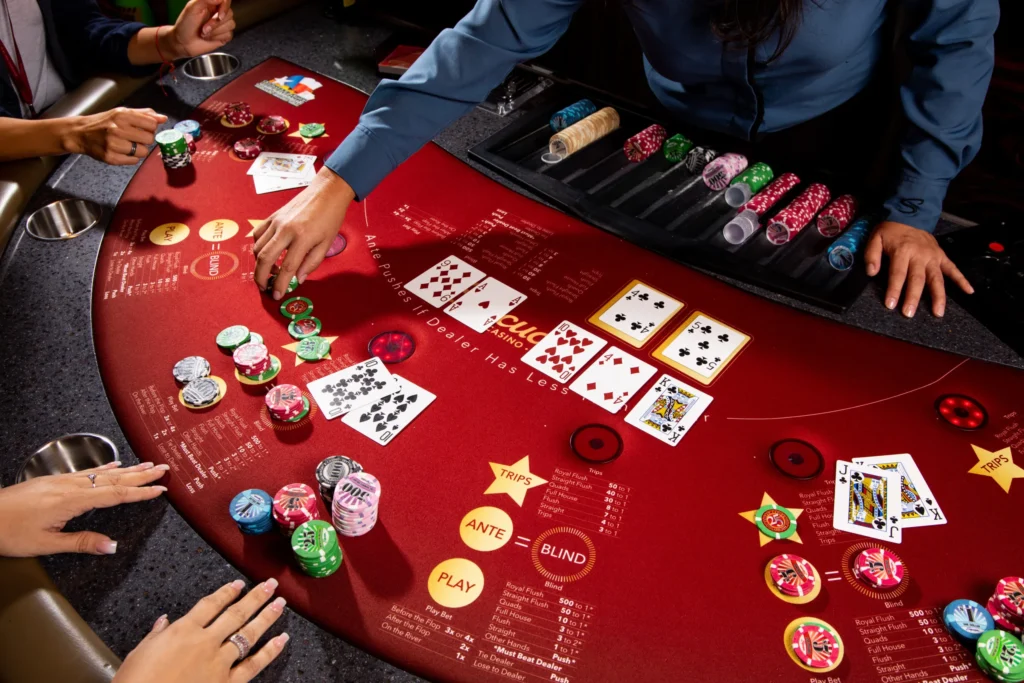Welcome to the ultimate guide to mastering Texas Holdem, the most popular form of poker played both online and offline. This blog post aims to provide you with a comprehensive strategy to elevate your game and gain an edge over your opponents. Texas Holdem is not just about the cards you hold; it’s about understanding the game dynamics, reading your opponents, and making the right decisions at the right time. Let’s dive in!
Understanding the Basics
The first step to mastering Texas Holdem is understanding the basic rules and objectives. Each player is dealt two private cards, and five community cards are dealt face-up on the “board.” The objective is to make the best five-card poker hand using any combination of your two private cards and the five community cards.
Understanding the positions at the table is crucial as it affects your strategy. The player to the left of the dealer is in the early position and has to act first, while the player to the right of the dealer is in the late position and acts last. The late position has an advantage as they can make decisions based on the actions of the other players.
Starting Hand Selection

Source: nnn.ng
Choosing the right starting hands is a critical aspect of Texas Holdem strategy. The strength and potential of your starting hands can significantly influence your chances of winning. High-value cards like Aces, Kings, Queens, and Jacks, and suited connectors like 10-Jack, Jack-Queen, or Queen-King are generally strong starting hands.
However, the value of your starting hands can vary based on your position and your opponents’ playing styles. For instance, if you’re in an early position, it’s advisable to play only with strong hands. But if you’re in a late position, you can afford to play a wider range of hands.
Pre-Flop Strategy
The pre-flop stage sets the tone for the rest of the hand. Your pre-flop strategy should be based on the strength of your starting hand and your position. If you have a strong hand, you might want to raise the pot. If your hand is weak, you might want to fold and save your chips for a better opportunity.
Reading your opponents’ actions is also crucial at this stage. If an opponent raises, they likely have a strong hand. If they call, they might have a mediocre hand. Adjust your strategy based on these observations.
Post-Flop Strategy
The flop can dramatically change the dynamics of the game. Your post-flop strategy should be based on the strength of your hand after the flop and the potential hands that the community cards could create.
If you have a strong hand, you might want to make a continuation bet to extract value from your opponents. If your hand is weak but has potential, you might want to check and see the next card for free. Reading the board and your opponents’ reactions is crucial to making informed decisions at this stage.
Calculating Pot Odds and Expected Value

Source: mypokercoaching.com
Pot odds are the ratio of the current size of the pot to the cost of a contemplated call. They are used to determine whether a call is profitable in the long run. To calculate pot odds, divide the total amount of money in the pot by the amount of money it will cost you to call.
Expected value (EV) is the potential long-term profitability of a decision. If the EV of a call is positive, it means that you can expect to make a profit in the long run by making that call. Understanding pot odds and EV is crucial to making profitable decisions in Texas Holdem.
Understanding Table Image
Your table image is how your opponents perceive your playing style. If you’re seen as a tight player, your opponents might fold to your raises, allowing you to steal pots. If you’re seen as a loose player, your opponents might call your raises with weaker hands, allowing you to extract value with your strong hands.
Maintaining a balanced table image and exploiting your opponents’ table image can give you a significant advantage. This is why it’s vital to play at respectable casinos such as SatoshiHero and frequent the same tables as you’ll get the bigger picture faster when playing with the same or similar style players.
Managing Bankroll and Bet Sizing
Proper bankroll management is crucial to sustaining your gameplay in the long run. You should only play with money that you can afford to lose and avoid going on tilt.
Bet sizing is another important aspect of Texas Holdem strategy. Your bet size should be based on the size of the pot, the strength of your hand, and what you want to achieve. For instance, if you have a strong hand and want to extract value, you might want to bet a large amount. If you have a weak hand and want to bluff, you might want to bet a small amount to minimize your risk.
Exploiting Player Tendencies
Every player has certain tendencies and patterns in their play. Some players might be aggressive and often bluff, while others might be passive and only play with strong hands. Understanding these tendencies and exploiting them can give you a significant advantage.
For instance, against aggressive players, you might want to play more conservatively and let them bluff into you. Against passive players, you might want to play more aggressively and put pressure on them.
Bluffing and Deception
Bluffing is an integral part of Texas Holdem strategy. It involves betting or raising with a weak hand to make your opponents think that you have a strong hand and fold.
However, bluffing should not be overused. It should be based on your table image, the board texture, and your opponents’ tendencies. For instance, if you have a tight table image, your bluffs are more likely to be believed. If the board is scary, your bluffs are more likely to succeed.
Reading Opponents and Poker Tells
Reading your opponents’ behaviors, body language, and verbal cues can give you valuable information about their hands. For instance, if an opponent suddenly becomes very talkative, they might be trying to distract you from their weak hand. If an opponent suddenly becomes very quiet, they might be trying to hide their strong hand.
However, be aware that experienced players might use reverse tells to deceive you. They might act strong when they are weak and act weak when they are strong.
Mental Game and Emotional Control

Source: thriveworks.com
Maintaining a strong mental game and emotional control is crucial in Texas Holdem. You will face bad beats and downswings, but it’s important to stay focused and not let your emotions affect your decision-making.
Strategies for managing tilt include taking breaks, practicing mindfulness, and focusing on the long-term profitability of your decisions rather than the short-term results.
Conclusion
Mastering Texas Holdem requires understanding the game dynamics, making informed decisions, and continuously learning and adapting. It’s not just about the cards you hold; it’s about how you play them.
Remember, practice makes perfect. The more you play, the more experience you gain, and the better you become. So, embrace the journey and enjoy the game!



